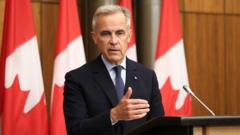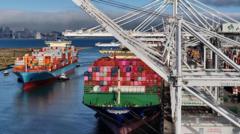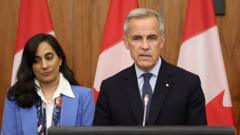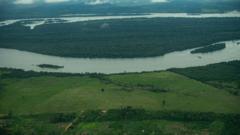With a canoe and tent, Jeronimo Kataquapit of the Attawapiskat First Nation exemplifies the growing discontent among Indigenous communities in Canada regarding Prime Minister Mark Carney's new legislation, which aims to accelerate economic growth through mining and other projects in the resource-rich Ring of Fire region of Ontario. Designated as a "special economic zone," the area, boasting C$90 billion worth of mineral resources, is under scrutiny as it becomes the focal point of Carney’s One Canadian Economy Act.
While this legislation is expected to spur investments, it raises alarms for indigenous leaders fearing infringement on their rights. “It’s not about consultation anymore; it’s about consent,” asserts Kataquapit, highlighting a shift in the government’s approach since the law was enacted. Environmental advocates echo these concerns, arguing that such legislation may bypass vital environmental reviews traditionally grounded in Indigenous knowledge and teachings.
Ontario Regional Chief Abram Benedict stresses the importance of integrating Indigenous perspectives into environmental assessments. According to Canada’s constitution, Indigenous rights must be respected, and any projects affecting their lands require prior consultation. However, the ongoing debate reveals discrepancies in how these consultations are interpreted. Justice Minister Sean Fraser indicates that First Nations' dialogue does not grant them absolute veto power—a stance met with criticism from Indigenous governance specialists.
Financial implications of disconnect between government and Indigenous communities are alarming. Legal battles against pipeline projects have cost taxpayers significantly, revealing how major projects can lead to lengthy disruptions and resistance. In an effort to address these issues, Carney has committed to engaging with Indigenous leadership as part of the economic strategy, discussing initiatives like the Indigenous Loan Guarantee Program.
Despite a recent call for consultations by the Assembly of First Nations Chief Cindy Woodhouse Nepinak, skepticism remains among Indigenous leaders who feel that their concerns are being sidelined in favor of expedient economic advancement. Chief Alvin Fiddler of the Nishnawbe Aski First Nation has spoken out against the law, suggesting it is irrelevant in their territories and calling for more accountability from the provincial government.
In reaction to the perceived threats posed by the new laws, nine First Nations have initiated a constitutional challenge, asserting their rights to self-determination are under attack. Criticism also flows from within Indigenous circles where even proponents of development question the federal approach to the One Canadian Economy Act.
However, not all is bleak. Some leaders, like John Desjarlais of the Indigenous Resource Network, remain hopeful for collaboration with the government that respects Indigenous rights while pursuing economic development. Desjarlais believes opportunities exist for joint ventures that can prioritize community needs alongside resource extraction efforts, paving the way for a more inclusive framework moving forward.
While this legislation is expected to spur investments, it raises alarms for indigenous leaders fearing infringement on their rights. “It’s not about consultation anymore; it’s about consent,” asserts Kataquapit, highlighting a shift in the government’s approach since the law was enacted. Environmental advocates echo these concerns, arguing that such legislation may bypass vital environmental reviews traditionally grounded in Indigenous knowledge and teachings.
Ontario Regional Chief Abram Benedict stresses the importance of integrating Indigenous perspectives into environmental assessments. According to Canada’s constitution, Indigenous rights must be respected, and any projects affecting their lands require prior consultation. However, the ongoing debate reveals discrepancies in how these consultations are interpreted. Justice Minister Sean Fraser indicates that First Nations' dialogue does not grant them absolute veto power—a stance met with criticism from Indigenous governance specialists.
Financial implications of disconnect between government and Indigenous communities are alarming. Legal battles against pipeline projects have cost taxpayers significantly, revealing how major projects can lead to lengthy disruptions and resistance. In an effort to address these issues, Carney has committed to engaging with Indigenous leadership as part of the economic strategy, discussing initiatives like the Indigenous Loan Guarantee Program.
Despite a recent call for consultations by the Assembly of First Nations Chief Cindy Woodhouse Nepinak, skepticism remains among Indigenous leaders who feel that their concerns are being sidelined in favor of expedient economic advancement. Chief Alvin Fiddler of the Nishnawbe Aski First Nation has spoken out against the law, suggesting it is irrelevant in their territories and calling for more accountability from the provincial government.
In reaction to the perceived threats posed by the new laws, nine First Nations have initiated a constitutional challenge, asserting their rights to self-determination are under attack. Criticism also flows from within Indigenous circles where even proponents of development question the federal approach to the One Canadian Economy Act.
However, not all is bleak. Some leaders, like John Desjarlais of the Indigenous Resource Network, remain hopeful for collaboration with the government that respects Indigenous rights while pursuing economic development. Desjarlais believes opportunities exist for joint ventures that can prioritize community needs alongside resource extraction efforts, paving the way for a more inclusive framework moving forward.




















